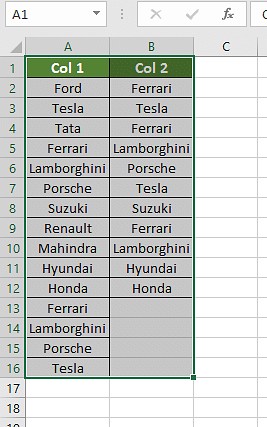Comparing data across two columns in Excel is a common task in data analysis. Doing this manually can be time-consuming and error-prone, especially with large datasets. Fortunately, Excel offers several efficient methods to compare columns and identify matches, differences, and duplicates quickly. This guide provides a comprehensive overview of various techniques to compare data in Excel between two columns.
Methods to Compare Two Columns in Excel
Excel provides a range of functionalities to compare data between two columns, catering to different needs and scenarios:
1. Conditional Formatting
Conditional formatting allows you to visually highlight cells based on specific criteria. To compare two columns:
- Select both columns.
- Go to Home > Conditional Formatting > Highlight Cells Rules > Duplicate Values. Choose a formatting style to highlight matching or unique values.
2. Equals Operator (=)
Using the equals operator, you can directly compare individual cells:
- Create a new column for results.
- In the first cell of the result column, enter a formula like
=A1=B1. This will return TRUE if the values in A1 and B1 are equal, and FALSE otherwise. - Drag the formula down to apply it to all rows.
You can enhance this by using the IF function to display custom messages: =IF(A1=B1,"Match","No Match").
3. VLOOKUP Function
VLOOKUP allows you to search for a specific value in the first column of a range and return a value in the same row from a specified column.
- In a new column, enter a formula like
=VLOOKUP(A1,$B$1:$B$10,1,FALSE). This searches for the value of A1 in column B. If found, it returns the value; otherwise, it returns an error. - Use
IFERRORto handle errors:=IFERROR(VLOOKUP(A1,$B$1:$B$10,1,FALSE),"No Match").
4. EXACT Function
The EXACT function performs a case-sensitive comparison between two text strings:
- In a new column, use the formula
=EXACT(A1,B1). This returns TRUE if the text in A1 and B1 is exactly the same (including case), and FALSE otherwise.
5. IF and AND/OR Functions
Combine IF with AND or OR for more complex comparisons:
=IF(AND(A1=B1,A1=C1),"Match in all three","")checks for matches across three columns.=IF(OR(A1=B1,A1=C1),"Match in at least two","")checks for matches in any two of three columns.
Choosing the Right Method
- Conditional Formatting: Best for quickly visualizing matches and differences, especially in large datasets.
- Equals Operator: Suitable for simple row-by-row comparisons and creating custom results.
- VLOOKUP: Useful for finding matches and retrieving corresponding data from another column.
- EXACT: Essential for case-sensitive text comparisons.
- IF with AND/OR: Ideal for complex comparisons involving multiple criteria.
Conclusion
Excel offers a versatile toolkit for comparing data between two columns. By understanding these methods and choosing the one that best suits your specific needs, you can efficiently analyze data, identify discrepancies, and gain valuable insights. Mastering these techniques will significantly enhance your data analysis capabilities in Excel.

